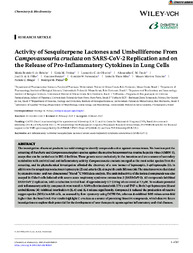Embrapa Clima Temperado
Activity of Sesquiterpene Lactones and Umbelliferone From Campovassouria cruciata on SARS?CoV?2 Replication and on the Release of Pro?Inflammatory Cytokines in Lung Cells
Autoria: RABELO, M. B. de O.; FREITAS, K. M.; OLIVEIRA, L. C. de; FRADE, A. C. M.; S. FILHO, J. D. de; HEIDEN, G.; FERNANDES, G. W.; SILVA, I. T.; TEIXEIRA, M. M.; BRAGA, F. C.; PÁDUA, R. M.
Resumo: The investigation of natural products is a valid strategy to identify compounds active against coronaviruses. We herein report the screening of Baccharis and Campovassouria plant species against the murine betacoronavirus murine hepatitis virus-3 (MHV-3), assays that can be carried out in BSL-2 facilities. These genera occur exclusively in the Americas and are a source of secondary metabolites with antiviral and anti-inflammatory activity. Campovassouria cruciata emerged as the most active species from the screening, and its phytochemical investigation afforded the discovery of a new isomer of leptocarpin, 3-epi-leptocapin (1), in addition to the sesquiterpenes lactones leptocarpin (2) and arturin (3), along with umbelliferone (4). The structures were elucidated by extensive mono- and two-dimensional 1H and 13C NMR data analysis. The antiviral activity of the isolated compounds was also assayed in Calu-3 cells infected with severe acute respiratory syndrome coronavirus 2 (SARS-CoV-2). All compounds inhibited SARS-CoV-2 replication, with a reduction in viral load of approximately 1.7-2.0 log when tested at 7.5 µM. To evaluate potential anti-inflammatory activity, compounds were tested in A549 cells stimulated with IFN-? and TNF-?. Both 3-epi-leptocarpin (1) and umbelliferone (4) inhibited interleukin-6 (IL-6) and IL-8 release significantly. Compound 1 reduced the production of reactive oxygen species (ROS) in A549 cells, as assessed by flow cytometry using DCFH-DA, whereas 4 exhibited ROS values seven-fold higher than the basal level. Our results highlight C. cruciata as a source of promising bioactive compounds, which deserve future investigations to explore their potential for the development of new therapeutic agents against inflammatory and viral diseases.
Ano de publicação: 2025
Tipo de publicação: Artigo de periódico
Unidade: Embrapa Clima Temperado

